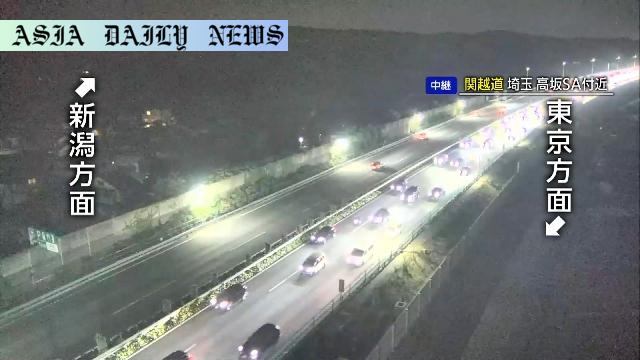Congestion clogs expressways, trains, and air travel across Japan as people rush back home after the spring holidays.

Japan’s Traffic and Travel Network Faces Massive Congestion
As Japan’s spring holiday period comes to a close, a wave of congestion has hit expressways, trains, and air travel across the nation. The sheer volume of travelers returning to major cities has left transport systems overwhelmed, a scenario that has become somewhat predictable during this time of year. Reports indicate that expressways, particularly those leading to metropolitan areas, witnessed significant traffic jams exceeding 30 kilometers in length in some areas.
Major Expressways Face Extensive Traffic Backlogs
Among the worst-hit were the inbound lanes of the Kobe-Awaji-Naruto Expressway, which experienced a 37-kilometer traffic backup near the Maiko Tunnel in Hyogo Prefecture. Similarly, the Kan-etsu Expressway near the Kawagoe Interchange in Saitama Prefecture, the Tomei Expressway near the Yokohama-Aoba Interchange in Kanagawa Prefecture, and the Chuo Expressway near the Kobotoke Tunnel all reported traffic jams of 27 to 29 kilometers. These extraordinary congestion levels reflect the immense volume of travelers heading back to urban centers such as Tokyo and Osaka.
Trains Struggle with Overcapacity
While roads were clogged, trains also saw a bustling rush. The Tokaido Nozomi bullet trains bound for Tokyo were fully booked on Monday afternoon, leaving little room for those looking to travel comfortably. Trains along the Tohoku and Joetsu Shinkansen lines also reportedly exceeded their seating capacity, highlighting the pressure being placed on rail services to accommodate returning travelers. Such scenarios are typical during Japan’s peak holiday seasons, and transportation networks are left scrambling to manage the overwhelming demand.
Domestic Flights Also Booked Heavily
Air travel, another vital component of Japan’s transportation system, saw similar congestion Monday. About 70% of domestic flight seats departing regional airports were fully booked, and many flights bound for Tokyo and Osaka were completely sold out. Passengers hoping for a more relaxed travel option were left with limited choices as airlines struggled to balance the demand for seats with their operational constraints. Some airlines noted that Tuesday could see a continuation of this congestion, as the peak return travel day coincides with the official end of many businesses’ holiday schedules.
Future Steps for Managing Holiday Congestion
The consistent predictability of congestion in Japan during holiday travel periods raises questions about how infrastructure improvements and travel demand management techniques can help mitigate such problems. Authorities in Japan might consider enhancing real-time traffic management systems on expressways, increasing the capacity of train services, and ensuring additional flights in anticipation of peak demands. Such measures could go a long way in making travel less stressful for millions of holiday-goers each year. Additionally, an emphasis on encouraging staggered travel schedules could reduce the extreme use of transport systems concentrated over a short span of time.
Commentary
The Impact of Congestion on Holiday Travel
The holiday period is often a time for relaxation, family gatherings, and the discovery of new destinations. However, in Japan, it also signals a familiar challenge: unprecedented congestion. For millions of people traveling back home after spring holidays, this annual cycle of overburdened roads, packed trains, and sold-out flights can turn what should be joyous moments into a test of patience. The repeated occurrence of such scenarios amplifies the urgent need for long-term solutions that better address this seasonal surge in demand.
How Peak Travel Burdens Transport Infrastructure
Japan’s efficient transportation systems, renowned worldwide for their precision and reliability, face a significant strain during holiday rush periods. Roads such as the Kobe-Awaji-Naruto, Kan-etsu, and Tomei Expressways become parking lots, while rail networks and airlines are pushed to the brink of overcapacity. What is noteworthy is not just the frustration this creates for travelers but also the ripple effects on the economy, from fuel wastage in traffic jams to delays that hamper productivity.
Adapting to Seasonal Travel Demands
To overcome these hurdles, Japan can lead the way in advanced congestion management. Intelligent transportation systems that dynamically adjust traffic flow and prioritize public transport can alleviate unnecessary delays. Introducing dynamic pricing for roads, rail, and air travel during peak times could also encourage staggered travel. Lastly, promoting remote work and flexible business schedules during peak holiday return times could help spread out demand effectively, reducing strain on the travel infrastructure.
Final Reflections
While congestion during peak travel seasons may seem unavoidable, it is crucial to see these challenges as opportunities to innovate and improve. Japan could emerge as a model for other nations looking to address the same issues, blending technology, policy, and behavioral change to deliver smoother travel for all. In the meantime, travelers would be wise to plan their journeys with as much foresight as possible, embracing flexibility and preparedness to better navigate the holiday rush.


